
Building a Documentation Culture
|
October 25, 2025
|
Create Your Organizational Change Management Plan in 9 Steps
Overview
You might be wondering how to navigate the often tricky waters of organizational change. Well, this article lays out a friendly nine-step framework that can help you create an effective change management plan. From defining what you want to achieve to gathering a diverse team and putting those changes into action, each step is backed by solid evidence. It shows that having a structured approach can really boost your chances of success and help you dodge those common pitfalls that often lead to failure.
Now, let’s dive into why this matters. By following these steps, you’re not just ticking boxes; you’re setting yourself up for a transformation that sticks. It’s all about making sure everyone is on the same page and that the process is documented well, so you can learn and adapt as you go. So, if you’re looking to make some changes in your organization, this framework could be just what you need!
Key Highlights:
- Clearly define change objectives to align organisational goals and expectations, reducing resistance.
- Assemble a diverse change management team to foster ownership and increase success probability by 30%.
- Develop a communication plan that includes key messages, target audiences, and feedback systems to improve engagement.
- Conduct a risk assessment to identify potential challenges and develop mitigation strategies for high-priority risks.
- Create customised training programmes using various methods to cater to different learning styles and ensure staff readiness.
- Implement changes with effective communication and adequate resources to reduce failure rates in transformation initiatives.
- Monitor and evaluate change through employee feedback, performance metrics, and regular cheque-ins to ensure alignment with objectives.
- Reinforce changes by recognising employee contributions, providing ongoing support, and fostering a culture of continuous improvement.
- Document the change management process, including objectives, strategies, and lessons learned to enhance future initiatives and maintain organisational knowledge.
Introduction
Creating a successful organizational change management plan is crucial for any organization wanting to thrive in today’s fast-paced business world. You might be wondering how to get started, right? By clearly defining your objectives and bringing together a dedicated team, you can tackle the complexities of transformation with a bit more confidence. But here’s the kicker: how can leaders make sure their change initiatives not only take root but also thrive, especially when faced with resistance and uncertainty?
Now, let’s dive into this! This article explores a comprehensive nine-step approach to crafting an effective change management plan. We’ll share insights that can significantly boost your chances of achieving those desired outcomes. So, grab a cup of coffee, and let’s get into it!
Define the Change and Objectives
To kick off a successful transformation effort, it’s super important to clearly define your organizational change management plan, specifying what changes you want to make—whether that’s bringing in new technology or reshaping teams. You might be wondering, what exactly are we trying to solve here? What benefits do we expect from this change? And how will we know if we’ve succeeded?
Writing down these details not only clarifies the purpose and expected outcomes of the organizational change management plan but also ensures that everyone is on the same page. At SowFlow, we see documentation as a systematic process that fits right into your organization, making sure all the important info is always updated and easy to find. This approach boosts clarity and supports effective transformation, which can significantly enhance project success rates. Did you know that organizations with strong transition oversight practices are nearly five times more likely to hit their targets compared to those without? As Scott Anderson points out, "With outstanding transformation oversight, your project is roughly seven times more likely to achieve goals than with inadequate transformation oversight."
By setting clear transformation goals and ensuring everyone understands the reasons behind the changes, organizations can lessen resistance—after all, 70% of transformation initiatives flop due to staff pushback and lack of leadership support. With up-to-date documentation, SowFlow helps create a structured approach to implementation that aligns with the organizational change management plan, leading to better outcomes and a smoother transition. Now, let’s dive into how you can make this work for you!
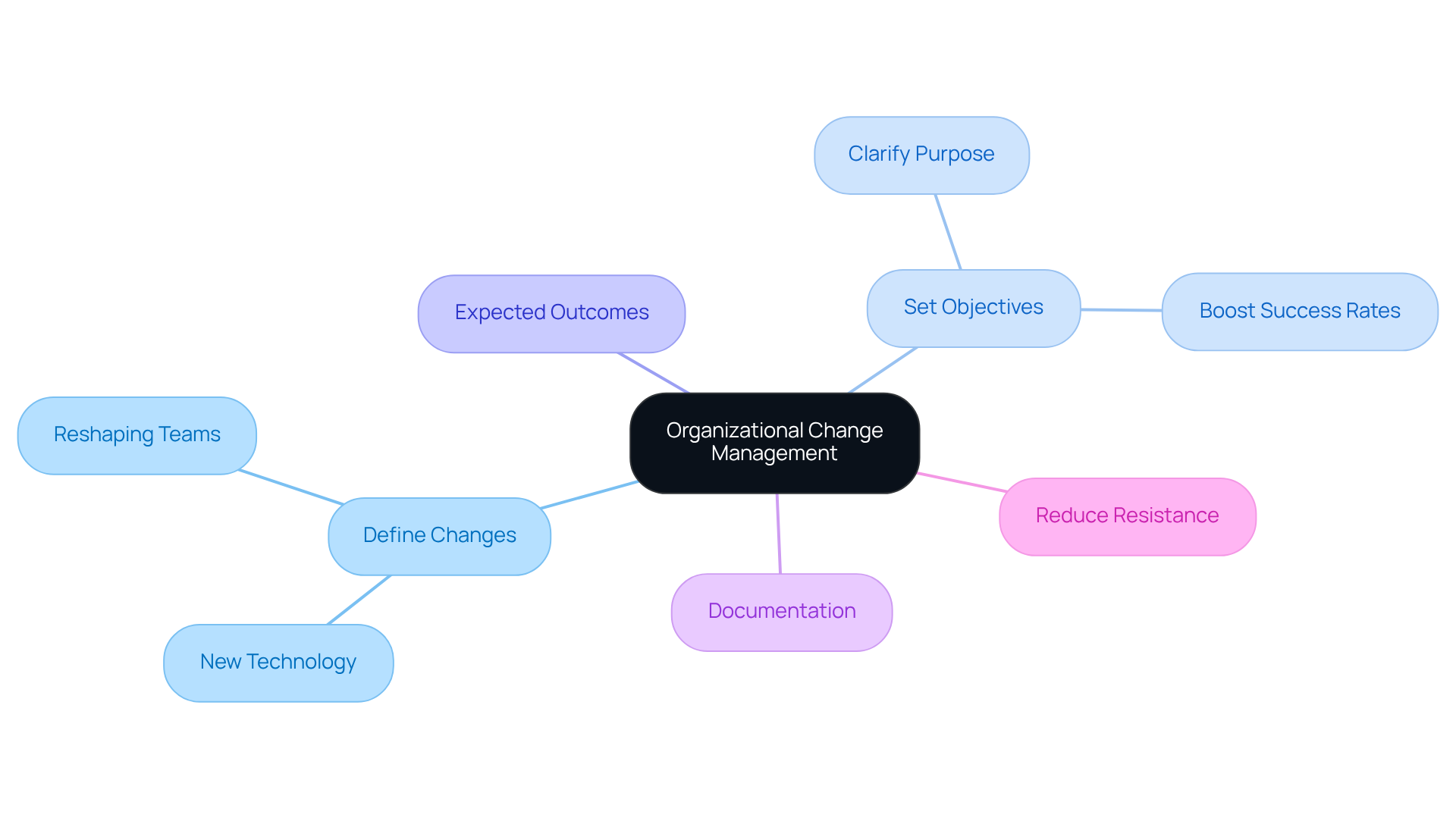
Develop a Change Management Team
To effectively navigate the transition management process, you might be wondering how to begin your organizational change management plan. One key step in implementing the organizational change management plan is to assemble a diverse team that includes key individuals from various departments. This collaborative approach not only fosters a sense of ownership but also increases the likelihood of success for the organizational change management plan. Did you know that when employees are genuinely engaged in transformation, the probability of success rises by 30%? So, let’s consider including the following roles:
- Project Manager: This person is responsible for overseeing the entire initiative, ensuring that timelines and objectives are met. Interestingly, projects with extremely effective sponsors are 79% likely to meet their objectives, while those with extremely ineffective sponsors only hit 27%.
- Department Representatives: Think about including individuals from impacted regions who can offer valuable insights and feedback. They help customize the adjustment to specific needs, and it’s worth noting that workers save 12.6 hours each week on management tasks when they participate in a collaborative approach.
- HR Personnel: These folks are essential for addressing training requirements and facilitating effective communication throughout the organization.
- IT Support: If technology transitions are involved, IT support is crucial to ensure that technical aspects are seamlessly integrated into the transition process.
Once your team is established, it’s vital to clarify each member's roles and responsibilities as part of the organizational change management plan. This clarity not only promotes accountability but also aligns efforts toward common goals. Research shows that projects with clearly defined roles are significantly more likely to meet their objectives. As Jodie Haughton puts it, "Projects where transition management was classified as 'excellent' were almost 8 times more likely to achieve or exceed project objectives than those with 'poor' transition management." By nurturing a structured yet adaptable team atmosphere, companies can more effectively handle the challenges of transition and improve overall efficiency.
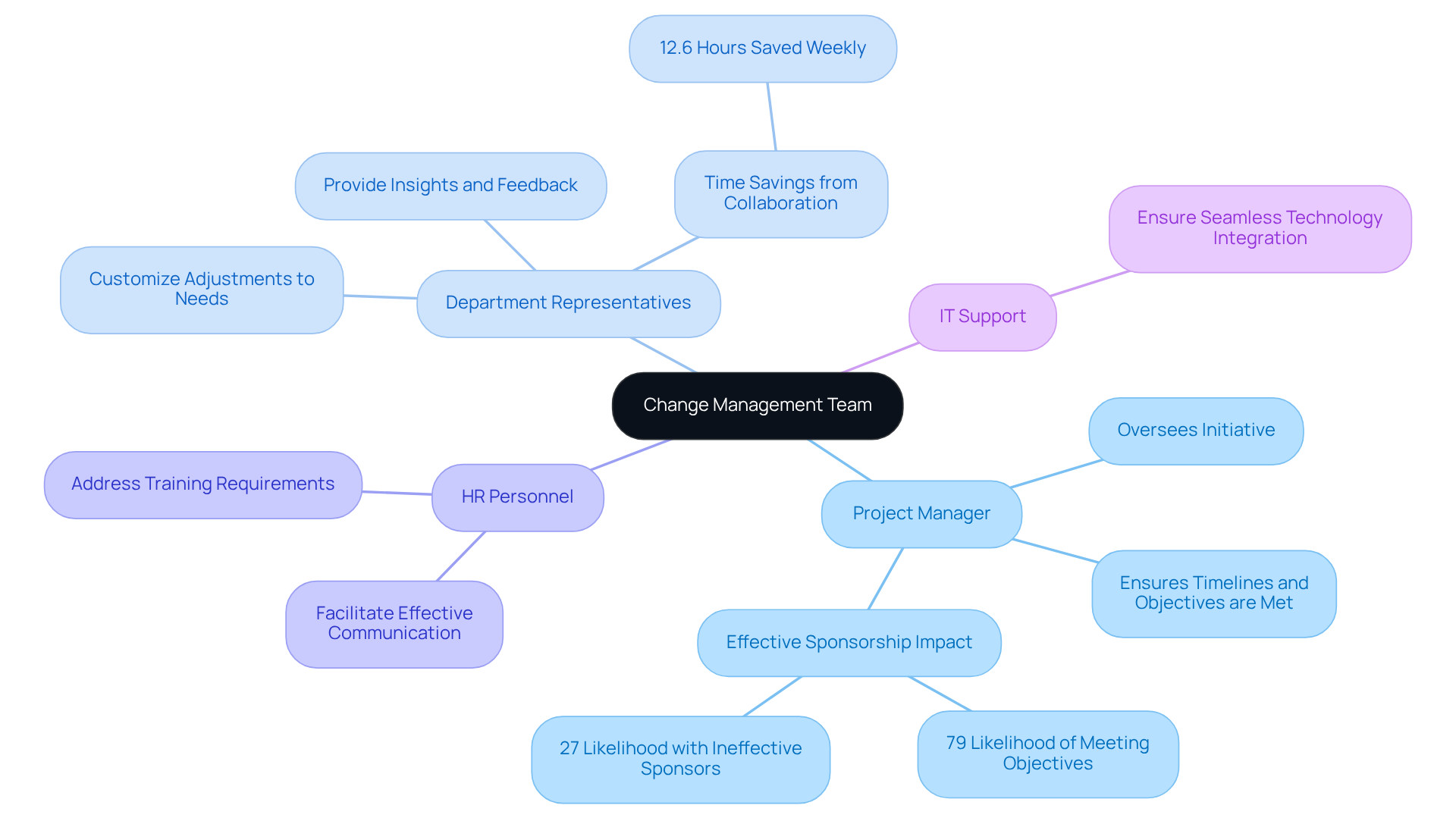
Create a Communication Plan
To effectively manage change, you might be wondering how to develop an organizational change management plan that truly works for everyone involved. It’s essential to cover a few key elements:
- Key Messages: Clearly articulate the core messages about the change initiative. This way, they resonate with the organization's vision and objectives.
- Target Audiences: Identify specific groups affected by the adjustment—think staff, management, and stakeholders. Tailor your messages to their unique perspectives and concerns.
- Communication Channels: Use a variety of channels like emails, meetings, and newsletters to share information. This ensures that all stakeholders get timely updates.
- Frequency of Updates: Set up a regular schedule for updates to keep everyone in the loop about progress and developments related to the change initiative.
Now, let’s dive into the importance of integrating feedback systems. This enables staff to voice their concerns and inquiries, promoting an open dialogue that boosts engagement. Did you know that research indicates organizations with effective communication strategies can increase their success rates by up to 38%? Plus, when you engage staff in the communication process, it can significantly reduce opposition to transformation. In fact, 74% of leaders believe understanding worker viewpoints is crucial for effective transition oversight.
However, there’s a catch—only 42% of staff feel they have a say in developing strategies for transformation. This highlights a gap between what leadership perceives and what staff experience. And let’s face it, organizations with ineffective transition management often see a drop in revenue and profit growth. This really underscores the need for a well-organized organizational change management plan. By prioritizing clear communication and feedback, you can navigate transitions more smoothly and keep employee morale high throughout the process.
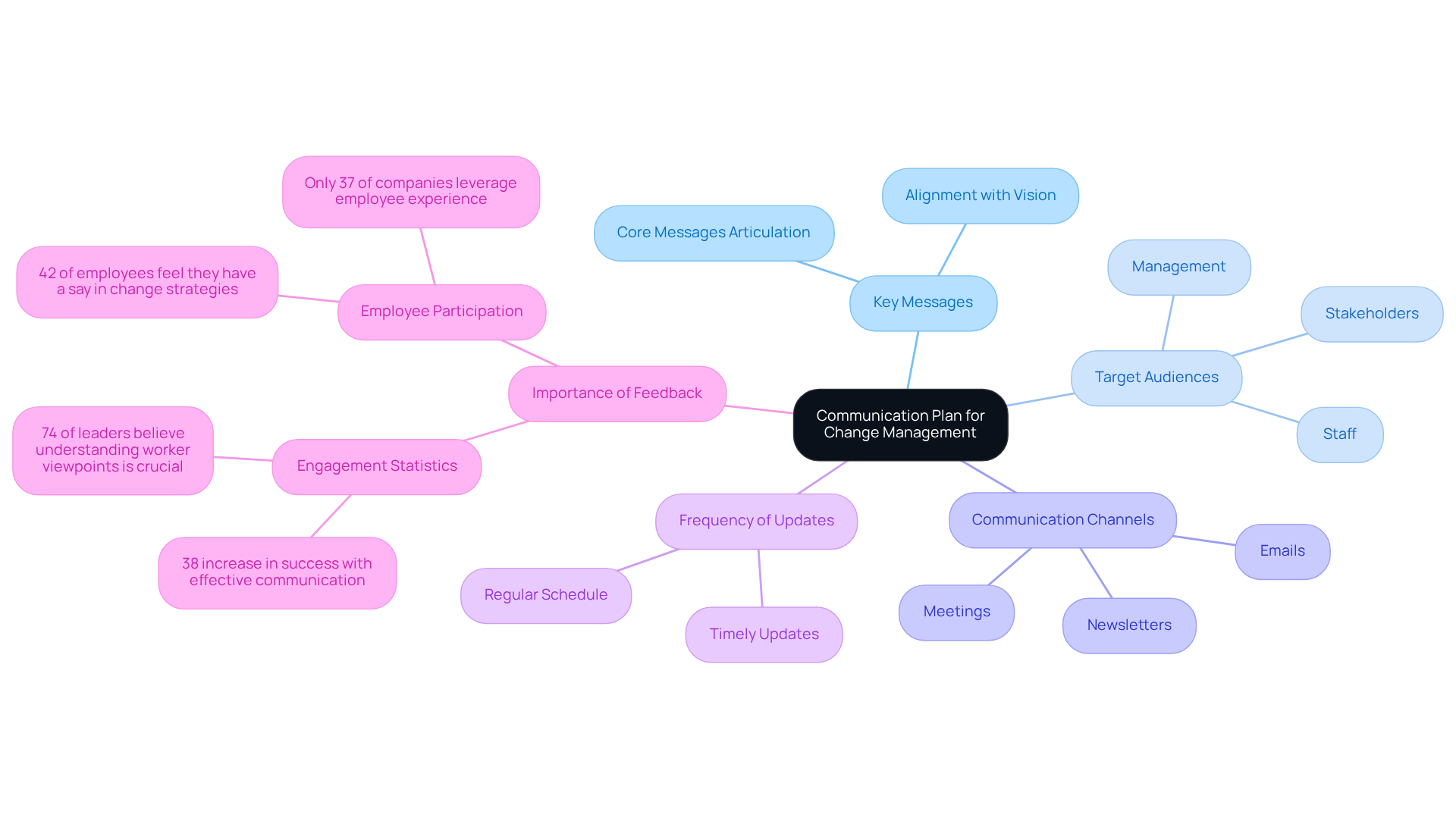
Conduct a Risk Assessment
To effectively manage transformation, you might be wondering how to begin with your organizational change management plan. Well, conducting a thorough risk assessment is crucial! This process involves several key steps:
-
Identify Potential Risks: First off, let’s pinpoint the risks that come with your change initiative. You know, common culprits like staff resistance, technical hiccups, and unclear communication can really throw a wrench in the works. In fact, did you know that 29% of employees say modifications aren’t communicated clearly? Tackling this risk is super important!
-
Evaluate Likelihood and Impact: Next, assess how likely each risk is to happen and what kind of impact it could have. This helps you prioritize the risks that might seriously disrupt your organizational change management plan during the transformation process. Studies show that organizations with strong transformation management strategies see a whopping 264% higher revenue growth. That really highlights why effective risk assessment is key!
-
Develop Mitigation Strategies: Now, for those high-priority risks, it’s time to craft some targeted mitigation strategies. Think about training programs to tackle workforce resistance or solid communication plans to keep everyone in the loop during the transition. When employees are involved in the transformation strategy, their desire to stick around can jump by 46%! It just goes to show how important inclusive methods are.
-
Document Findings: Finally, don’t forget to document your risk assessment results. Make sure the management team is fully on board with these risks. This documentation will be your go-to reference, helping you proactively tackle any challenges that pop up.
By adhering to these steps outlined in the organizational change management plan, organizations can boost their resilience and adaptability during transformation initiatives, leading to more successful outcomes. So, why not dive in and start assessing those risks today?
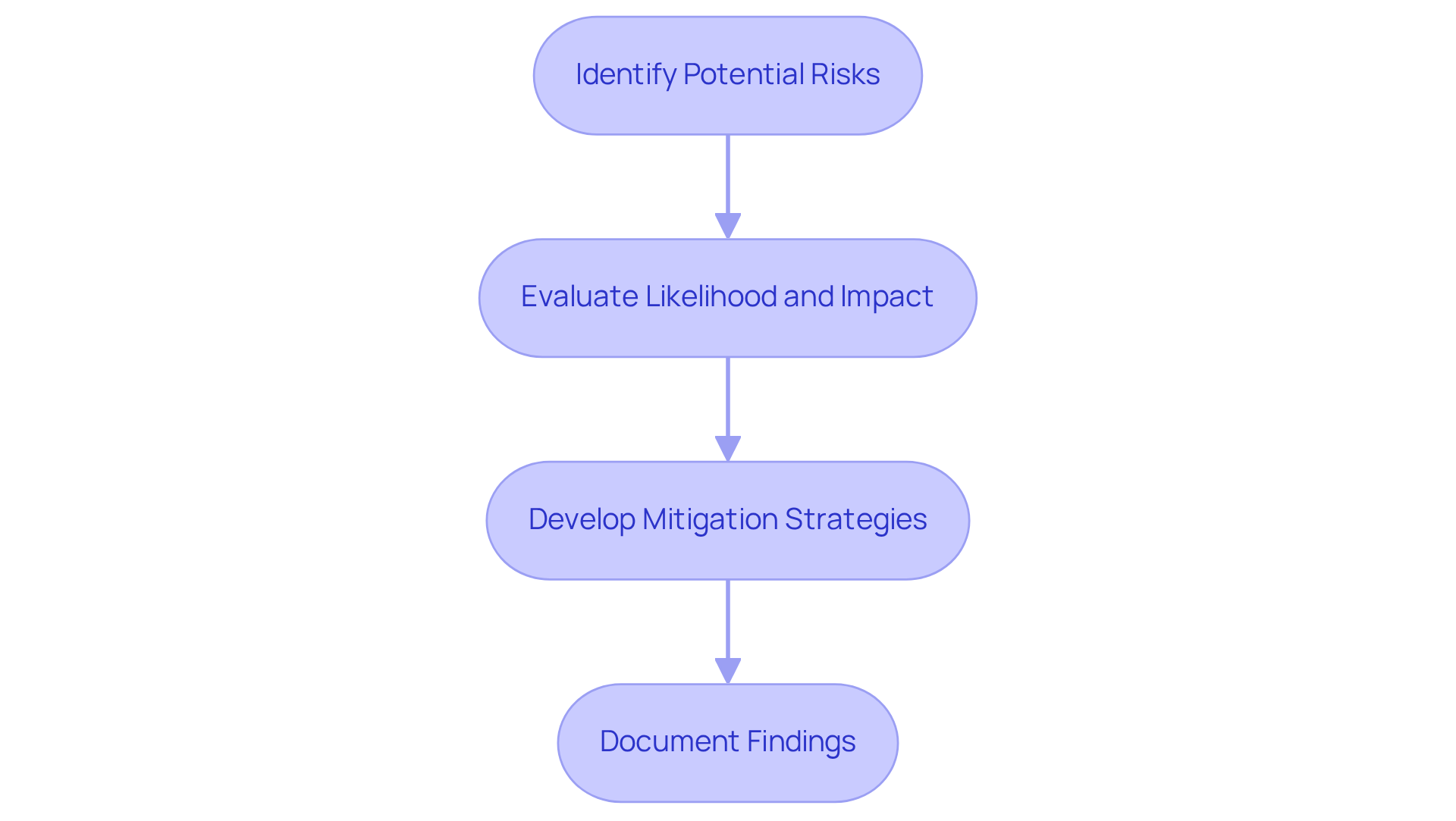
Develop Training Programs
Creating customized training programs is super important for providing your team with the specific skills and knowledge necessary to effectively implement the organizational change management plan. You might be wondering how to make these programs work for everyone, right? Well, consider mixing up your training methods to fit different learning styles:
- Workshops or Seminars: These are great for hands-on learning! They let employees dive right into the material and practice new skills in a friendly, supportive setting. Plus, you can use SowFlow's user guide creation tools to whip up clear and concise materials that really enhance these sessions.
- Online Courses: Offering flexible access to training materials means folks can learn at their own pace, fitting it around their busy schedules. And don't forget to support these courses with SowFlow's instant documentation updates to keep the content fresh and relevant.
- One-on-One Coaching: Sometimes, personalized help is just what someone needs to tackle their own challenges and boost their learning. This way, staff can feel confident about adapting to new situations. You can leverage SowFlow's capabilities to create customized resources that cater to individual needs.
Now, to really make these training initiatives shine, ensure all your materials are clear and easy to access. It’s a good idea to arrange your training sessions well in advance of the organizational change management plan implementation, providing everyone enough time to prepare and digest the information. This proactive approach not only boosts understanding but also fosters a culture of ongoing learning—something that’s essential when navigating the complexities of transformation.
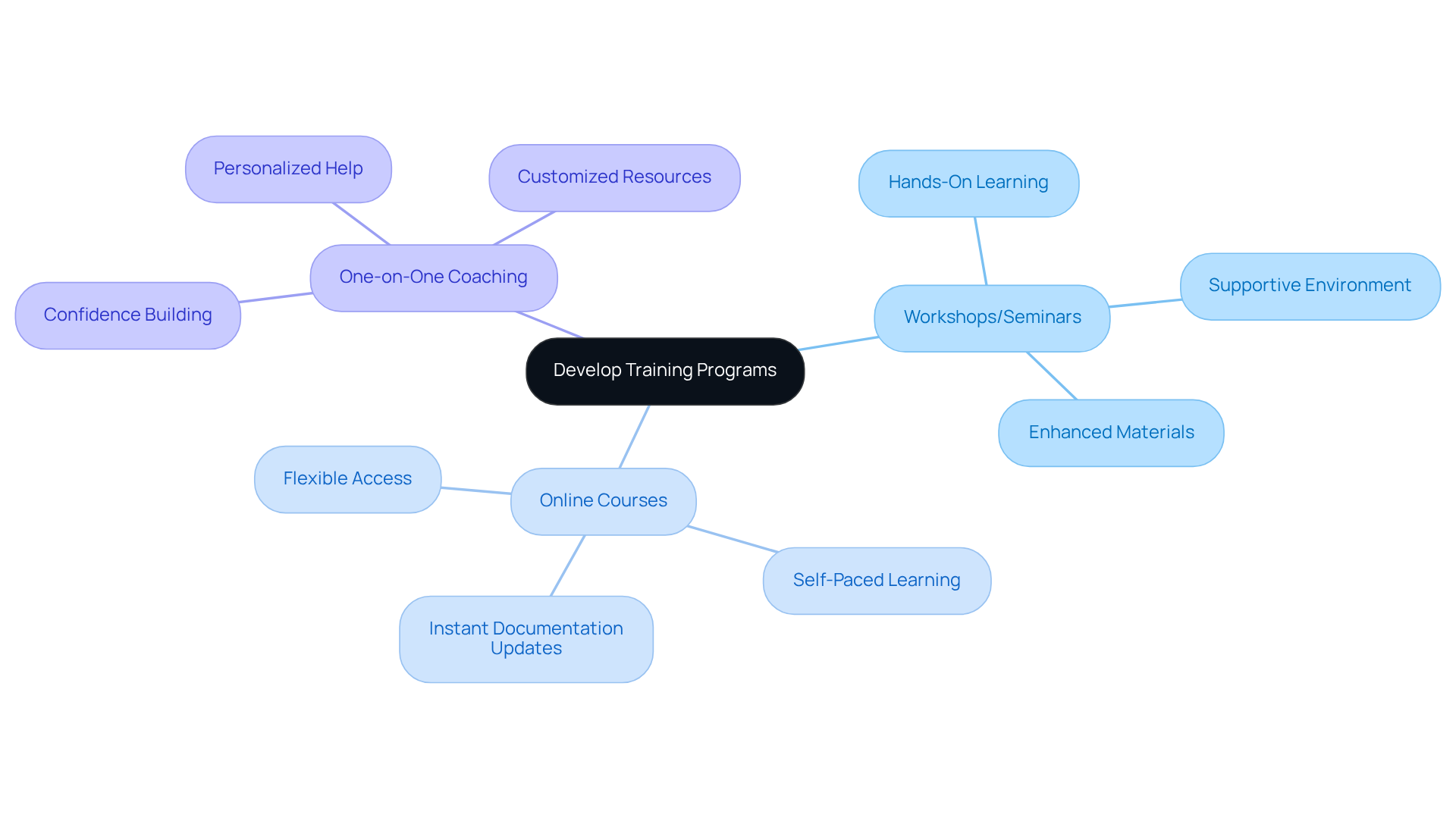
Implement the Change
Let's talk about making those modifications according to your established plan. You might be wondering what key actions to focus on:
-
First off, it’s crucial to communicate the change effectively to everyone involved. This way, all stakeholders can grasp the objectives and their roles in the process. Effective communication is key! Did you know that only about 20% of the workforce understands changes they face under top-down strategies? Compare that to 54% who get it when open-source communication is used. Quite a difference, right?
-
Next up, providing the necessary resources and support can really help smooth out the transition. Organizations that encourage employee participation and offer ample resources tend to dodge that pesky 60-70% failure rate in their organizational change management plan for transformation initiatives. Isn’t that a relief?
-
And don’t forget to keep an eye on the implementation process! Monitoring closely allows you to tackle any issues that pop up. Projects that follow a strong organizational change management plan during transitions are actually up to seven times more likely to hit their targets. Using Key Performance Indicators (KPIs) to track metrics such as adoption speed and final utilization is super important for gauging the effectiveness of the organizational change management plan.
-
Now, let’s encourage some input from your staff during this phase. You might be surprised at how much insight they can provide! Getting them involved not only fosters a sense of ownership but also boosts the chances of successful execution. Organizations that include personnel in decision-making often see a 15% bump in success rates. So, what do you think? Ready to take these steps?
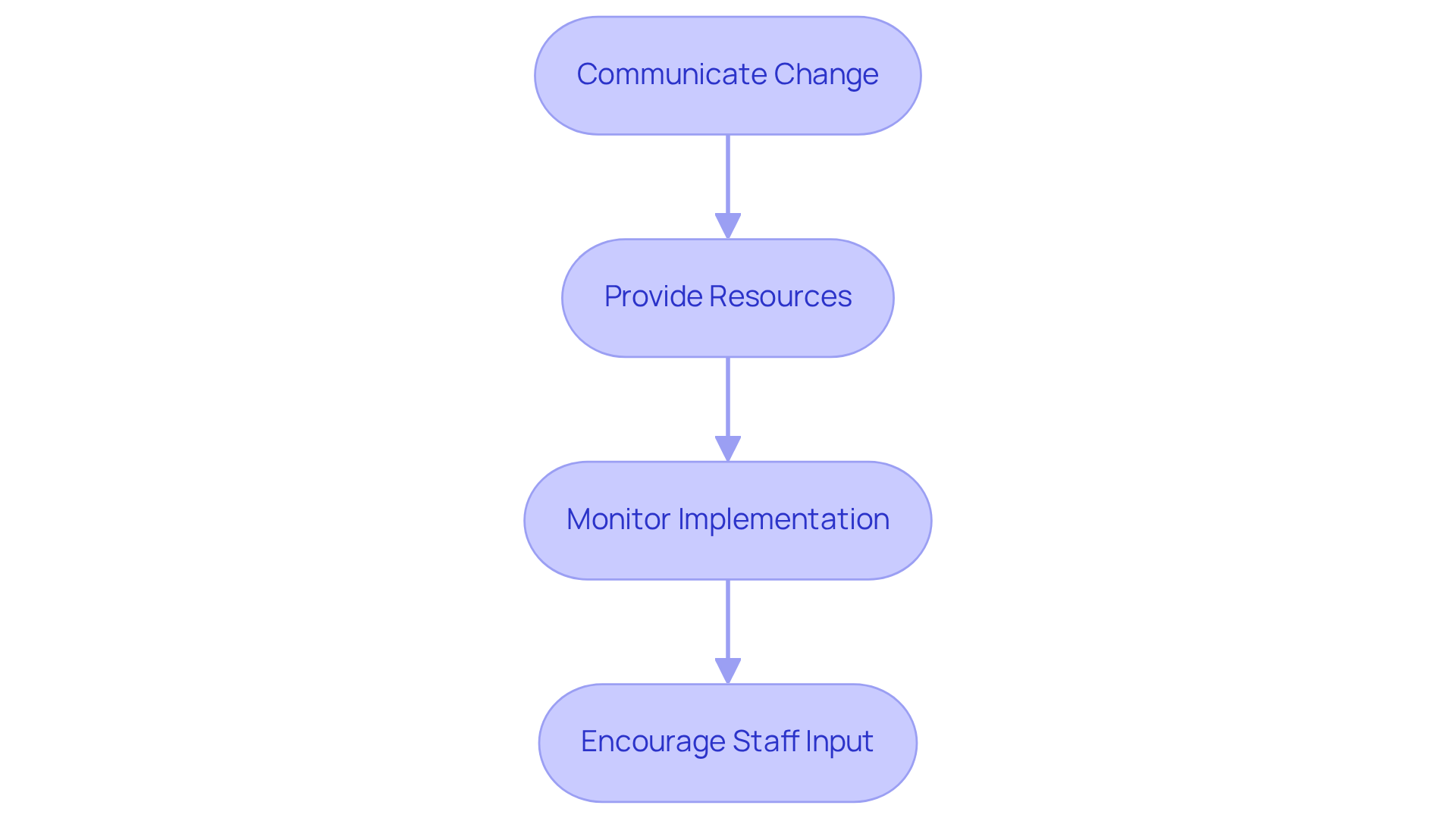
Monitor and Evaluate the Change
To effectively monitor and assess the success of transformation initiatives, you might be wondering how to establish robust metrics that provide clear insights into staff feedback and overall satisfaction. Here are some key strategies to consider:
-
Employee Feedback and Satisfaction Surveys: Regularly gathering feedback through structured surveys is a great way to gauge employee sentiment during the change process. Did you know that research shows staff readiness to support organizational transformation has significantly dropped from 74% to only 38% over five years? Plus, only 21% of workers globally are highly involved! This highlights just how crucial engagement is in transformation initiatives. Involving employees early in the transition can foster a sense of ownership and reduce resistance, ultimately boosting the chances of successful implementation.
-
Performance Metrics Related to Change Objectives: Now, let’s dive into tracking specific performance metrics aligned with your change objectives. For example, organizations that measure compliance with new processes are more likely to meet or exceed project goals—76% of those who measured compliance achieved this success! Metrics like the adoption rate of new systems and process compliance ratings can offer valuable insights into how effectively employees are applying their trained skills in real-world scenarios.
-
Regular Check-Ins with the Transition Coordination Team: Establishing a routine for check-ins with the transition coordination team ensures ongoing dialogue about progress and challenges. This proactive approach allows for timely adjustments based on feedback and performance data, which is essential for maintaining momentum and addressing any issues that arise.
Employing these strategies not only helps evaluate the effectiveness of your modifications but also highlights areas for further enhancement. Organizations that prioritize feedback systems and performance metrics can significantly improve their transformation results. In fact, studies indicate that effective transformation can yield returns of 3 to 6 times the initial investment! As Kiprotich Patrick wisely points out, "Successful organizations don’t regard transformation management as guesswork; they consider it a measurable, strategic discipline.
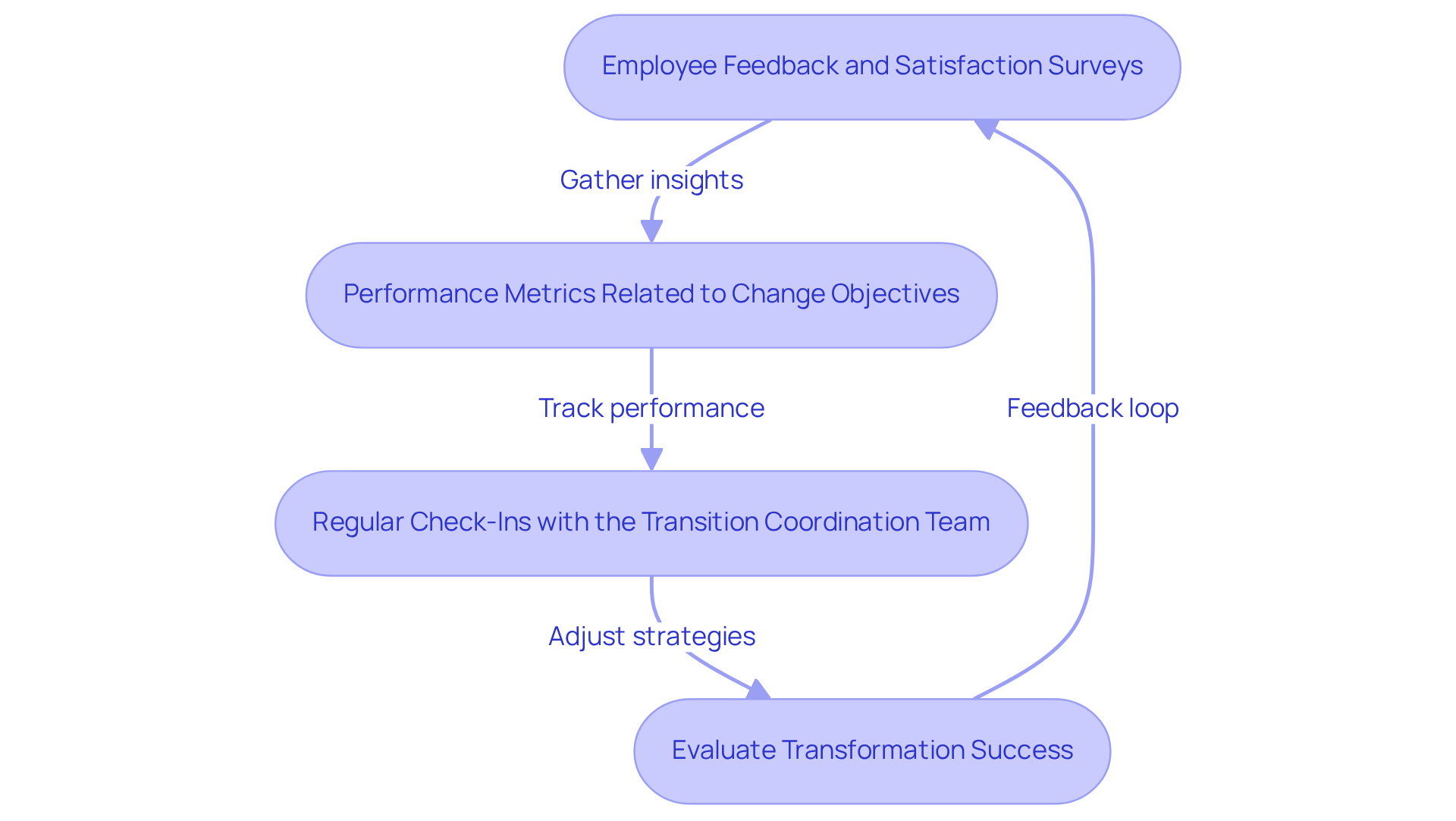
Reinforce and Sustain the Change
To effectively reinforce and sustain an organizational change management plan, you might be wondering what strategies could work best. Here are a few ideas:
-
First off, recognize and reward employees who actively embrace the change. This not only fosters a sense of value and belonging but also makes a huge difference. Research shows that workers who feel valued are 56% less likely to seek new job opportunities (Gallup), which is a big win for retention during transitions.
-
Next, consider providing ongoing training and support. This equips your staff with the necessary skills and knowledge to adapt to new processes. Think about it: investing in development boosts confidence and aligns perfectly with the 50% success rate observed when implementation timelines are clearly communicated (Gallup).
-
Now, let’s talk about communication. Regularly sharing the benefits and successes of the change can really help maintain momentum and engagement. Gallup research indicates that workers who receive valuable feedback about their performance are five times more likely to be engaged, which is crucial during times of transition.
-
And what about fostering a culture of continuous improvement? Encouraging feedback can refine processes and enhance worker satisfaction. Plus, studies reveal that recognition can increase output by 17% when individuals feel valued (Deloitte).
-
Don’t forget about peer-to-peer recognition! It’s actually 36% more likely to enhance financial performance compared to manager-led recognition (Deloitte).
By emphasizing acknowledgment and assistance, companies can create a supportive atmosphere that’s ideal for implementing an organizational change management plan. This ultimately leads to enhanced employee involvement and performance. So, what do you think? Ready to dive into these strategies?
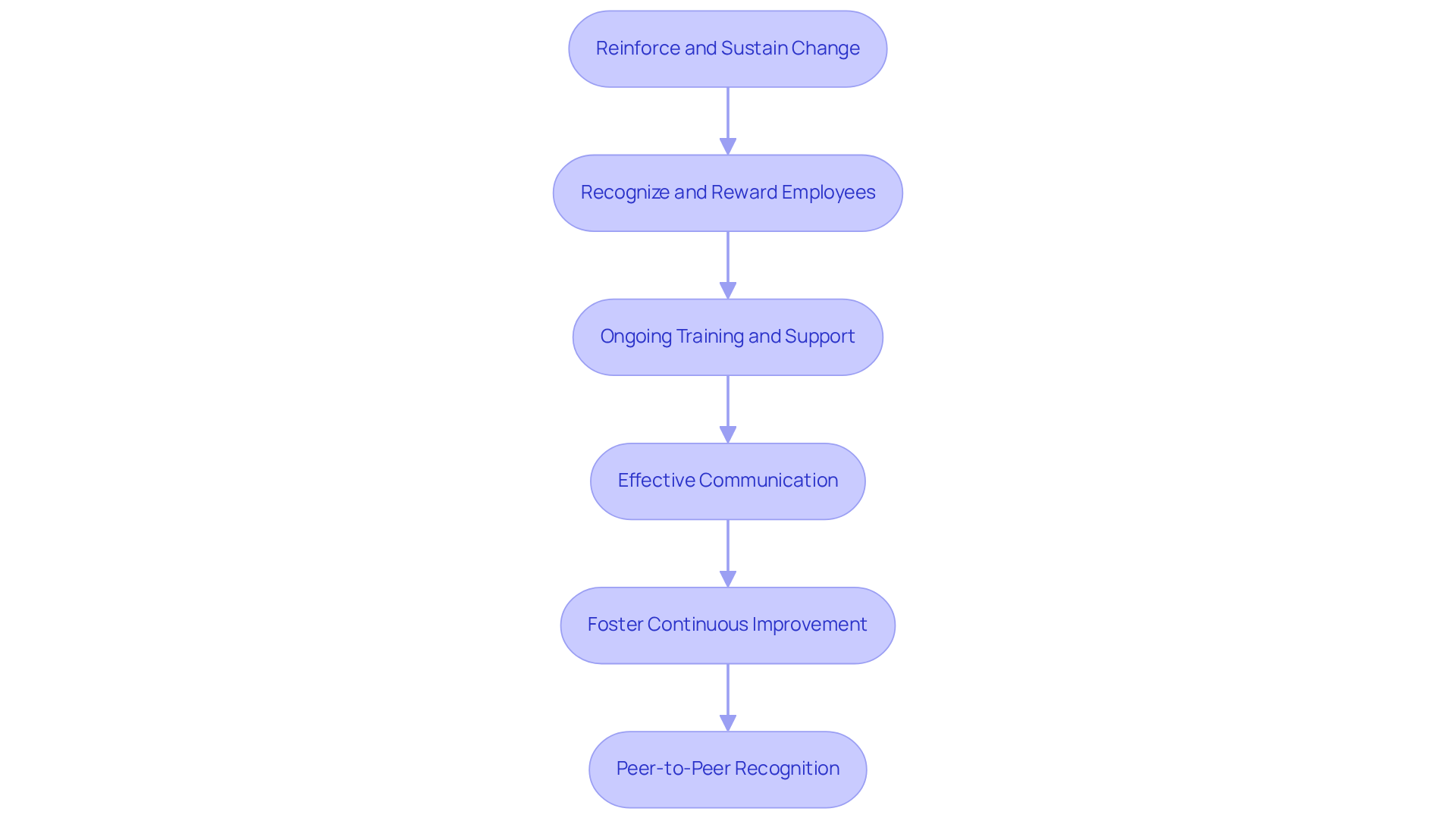
Document the Process
You might be wondering why comprehensive documentation of the transformation management process is so important. Well, it’s crucial for fostering a culture of ongoing improvement in any organization. So, what should you include? Let’s break it down:
- Initial Objectives and Rationale: Start by clearly outlining the goals of your change initiative and the reasons behind it. This sets the stage for understanding the aim of the transformation and helps align everyone with the vision.
- Strategies Implemented and Outcomes: Next, document the specific strategies you used during the transition and their results. This not only sheds light on what worked but also points out areas that could use a little tweaking.
- Lessons Learned and Recommendations: Finally, capture the insights you gained throughout the process, including both successes and challenges. Suggestions for future efforts can help teams avoid past mistakes and refine their adaptation strategies.
Now, let’s talk about how SowFlow can make this whole process a breeze. It empowers teams with instant access to documentation, making workflow sharing efficient and ensuring that all the relevant info is right at your fingertips. With SowFlow’s user-friendly tools, like customizable templates and real-time collaboration features, you can easily keep your documentation up to date in our fast-paced business world.
Did you know that a staggering 70% of transformation initiatives fail? Often, this is due to poor management and a lack of proper documentation, with only 34% managing to succeed. By keeping a detailed record of your change process as part of your organizational change management plan, you can significantly boost your chances of success in future initiatives. Plus, organizations that focus on effective communication and documentation are 50% more likely to seize long-term growth opportunities. Firms with successful communication strategies see a 38% boost in achievement! This documentation isn’t just paperwork; it’s a valuable resource for future projects as part of the organizational change management plan, ensuring that the lessons learned don’t slip through the cracks and that your organization can adapt and thrive.
It’s also worth noting that 41% of employees cite mistrust in their organization as a key reason for resisting change. This highlights the need for clear communication. As the WalkMe Team points out, "Studies indicate that 70% of change projects fail, with resistance and lack of management support being primary factors." So, let’s make sure we’re all on the same page!
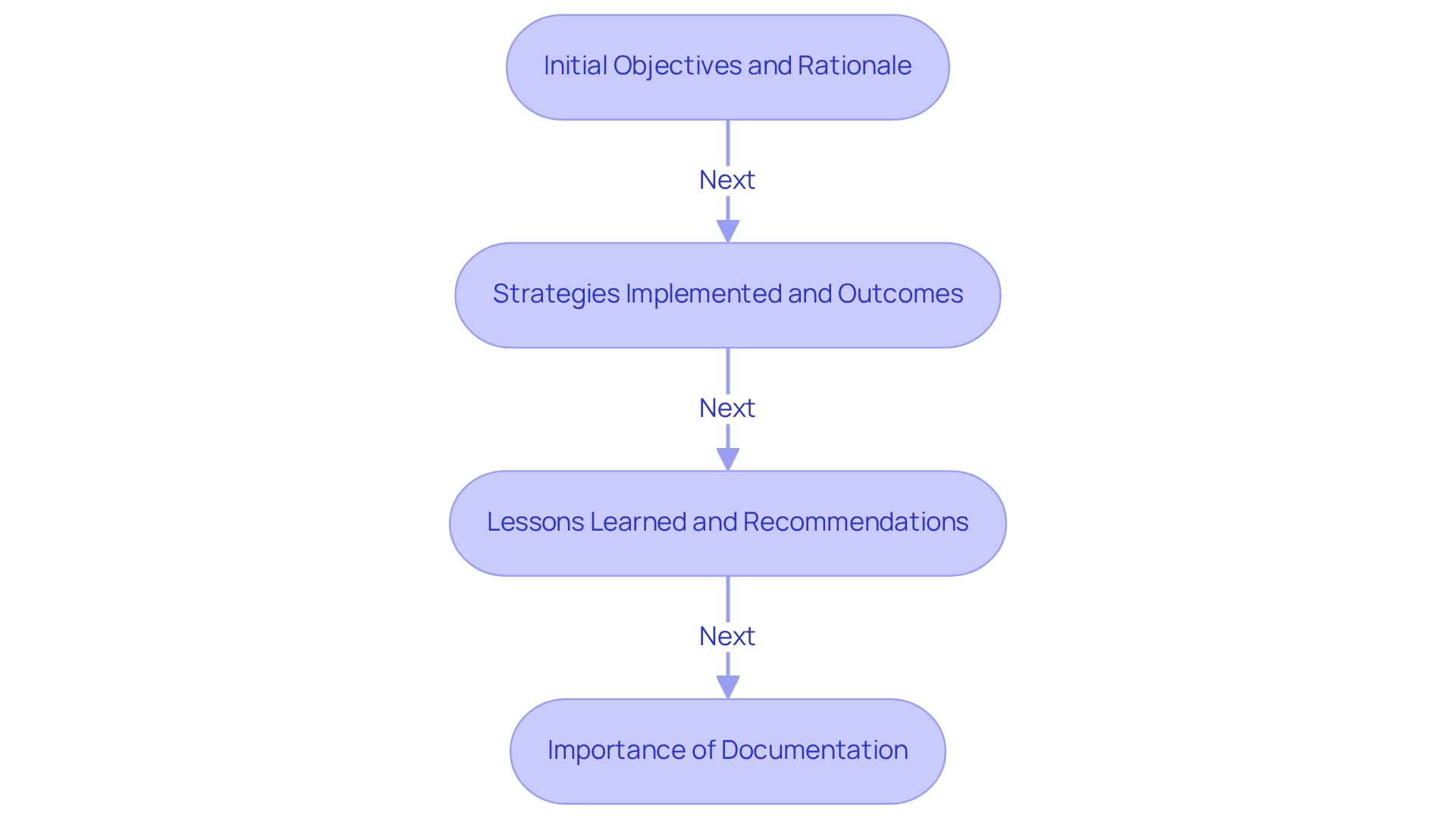
Conclusion
Creating an effective organizational change management plan is essential for navigating the complexities of transformation within any organization. You might be wondering how to get started, right? By clearly defining the change, assembling a diverse change management team, and developing a robust communication plan, you can significantly enhance your chances of success. Each step outlined—from conducting risk assessments to implementing and reinforcing change—plays a critical role in ensuring that the transition is smooth and well-received by all stakeholders.
Now, let’s dive into the importance of documentation throughout this process. Organizations with strong documentation practices are more likely to achieve their transformation goals. By actively involving employees, providing necessary training, and keeping those lines of communication open, you can foster a culture of engagement and adaptability. This is crucial, especially since a significant percentage of transformation initiatives fail due to resistance and inadequate support.
Ultimately, the successful implementation of your organizational change management plan not only leads to improved project outcomes but also empowers your organization to thrive in an ever-evolving business landscape. Emphasizing strategic planning, clear communication, and continuous feedback will pave the way for sustainable growth and long-term success. So, take these insights to heart and actively integrate them into your change management strategies for a more resilient future. Ready to embrace the change?
Frequently Asked Questions
What is the first step in a successful organizational change management plan?
The first step is to clearly define the change and its objectives, specifying what changes are desired and the expected benefits. This documentation helps clarify the purpose and ensures everyone is aligned.
Why is documentation important in the change management process?
Documentation is important as it boosts clarity, supports effective transformation, and ensures that all critical information is updated and accessible, which can significantly enhance project success rates.
How does strong transition oversight impact project success?
Organizations with strong transition oversight practices are nearly five times more likely to hit their targets compared to those without. Effective oversight increases the likelihood of achieving project goals.
What role does resistance play in transformation initiatives?
Resistance can significantly hinder transformation efforts, with 70% of initiatives failing due to staff pushback and lack of leadership support.
What is the significance of forming a change management team?
Assembling a diverse change management team fosters ownership and increases the likelihood of success. Engaged employees in transformation initiatives can raise the probability of success by 30%.
What key roles should be included in a change management team?
Key roles include a Project Manager, Department Representatives, HR Personnel, and IT Support. Each role contributes to different aspects of the transition, promoting collaboration and accountability.
How does clarity in roles and responsibilities affect project success?
Clarity in roles and responsibilities promotes accountability and aligns efforts toward common goals, significantly increasing the likelihood of meeting project objectives.
What are the essential elements of a communication plan in change management?
Essential elements include key messages about the change initiative, identification of target audiences, selection of communication channels, and a regular schedule for updates.
How does effective communication impact organizational change success?
Organizations with effective communication strategies can increase their success rates by up to 38%. Engaging staff in the communication process helps reduce opposition to transformation.
What gap exists between leadership and staff regarding communication in change management?
While 74% of leaders believe understanding worker viewpoints is crucial for effective transition oversight, only 42% of staff feel they have a say in developing strategies for transformation, indicating a disconnect between leadership perceptions and staff experiences.
👍
What others are liking
5 Steps to outline your ideal documentation structure
5 MINS READ
Where to start the your journey of mapping out your ideal documentation structure, aligning it with the very heartbeat of your organization?
Defining a winning level of detail in your process
3 MINS READ
What is too much detail, and what is too little? This article described in that winning level detail about what detail is enough.





